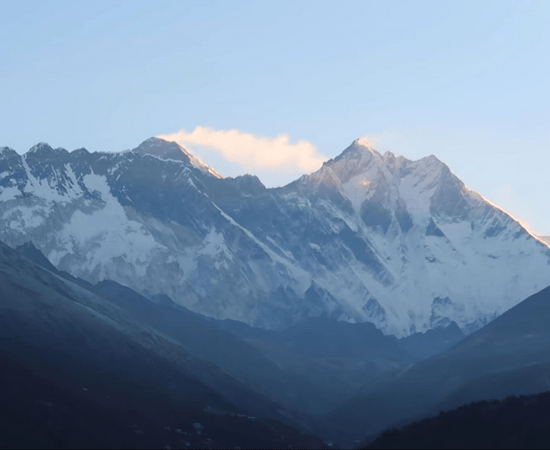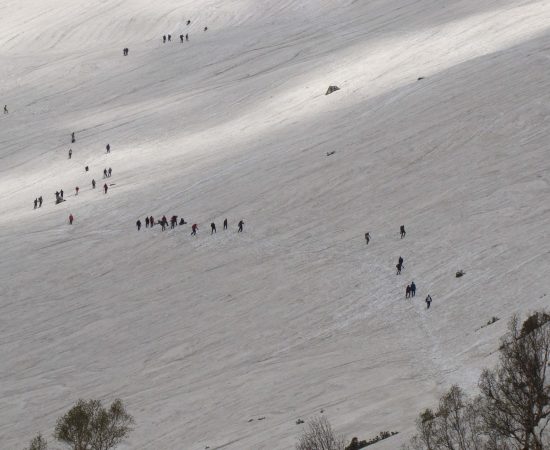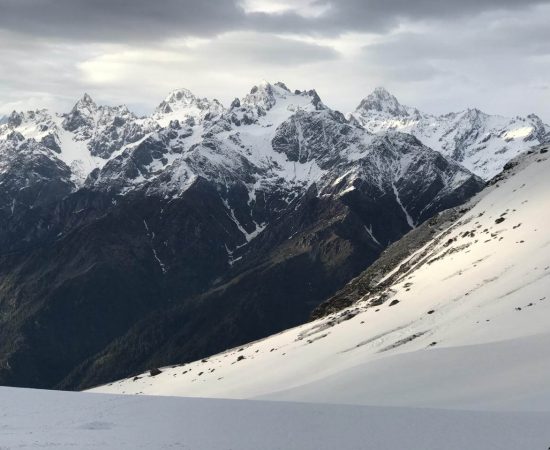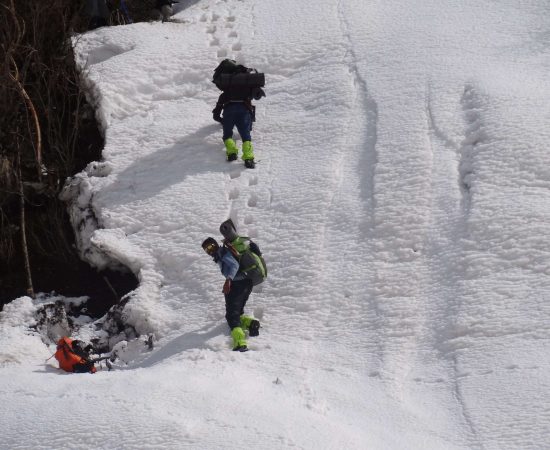BADA BHANGAL TREK
Manali, Himachal Pradesh
Rated 4.9/5.0 on TripAdvisor. 550 Reviews


Key Highlights
- Altitude : 4900m/16000ft
- Time : 10 Days - 09 Nights
- Region: Region: Manali/ Bir)
- Best Time: June to October
- Distance: 80kms
- Grade: Difficult
Overview
BADA BHANGAL TREK
One of Himachal Pradesh's most challenging and dangerous hikes is the Bada Bhangal Trek. At 4875 metres above sea level, it is a challenging hike. One of the most beautiful and little-known areas in the Western Himalaya is an alpine landscape between the Kullu Valley and Dharamshala. You may experience the magnificent vista of the Dhauladhar and Pin Panjal mountains on the Bara Bhangal trek. Lama Dugh, Riyali Thach, Kalihani, Devi ki Marhi, Dal Marhi, Marhi, Plachak, and Rajgundha are the principal tourist destinations along the road. The major highlight of this trek which attracts both novice and experienced adventure enthusiasts are the two massive passes which one has to cross, namely Kalihani Pass and Thamsar Pass. And in between these two passes is the Bada Bhangal glacier. This trek is not for the faint of hearts as this trek requires a lot of perseverance and endurance to tackle the unforgiving terrain and unpredictable weather of the region.
It is better to do this journey in June, the month before the monsoon, or in mid-September and October, the months after the monsoon. Due to heavy snowfall that clogs the hiking path, this journey is blocked during the winter. As a result of the region's heavy rainfall during the monsoon season, we advise against walking here.
Cost Per Person
Key Highlights
- Altitude : 4900m/16000ft
- Time : 10 Days - 09 Nights
- Region: Manali/ Bir
- Best Time: June to October
- Distance: 80kms
- Grade: Difficult
Complete
➽ Itinerary of Trek
This day marks the beginning of our trek as the team will assemble in Manali and report at the designated lodging(information of the lodging will be shared prior to your arrival in Manali. Here, you will be received by one of our representatives and then we will proceed with all the necessary paperwork, briefing and planning. After all the formalities have been taken care of, we will give you ample time for local sightseeing or for some last minute shopping if you have missed out on some items from the ‘Things to carry’ list. This is the last location where you can stock up on all the goods, as we will be saying goodbye to civilization. Overnight stay in Hotel/Guest House.
We'll start our trek to Loma Dugh after breakfast. The trip starts in a thick deodar and pine forest and ends in Manali's verdant valleys. The sun will shine through the trees along the journey, creating a stunning scene of light and shadow. A tough slope will be waiting for us as we ascend. Once at the top, one can observe Deo Tibba and Indrasan, which are both stunning. The route then descends steeply to the campground, which is located on the right side of a ridge, after traversing this challenging height. We soon find ourselves in a broad alpine meadow surrounded by untamed trees and blooming plants. We travelled for 4-5 hours before reaching Loma Dugh. A peaceful night may be had there in a nice setting.
We'll climb to Riyali Thach today for around three or four hours. Below Khand Pari Tibba, we'll continue going straight upwards (4000m). Although the mentally taxing steep path up the vertical hill is captivating, the scenery along the way. We finally reach the Riyali Thach campsite after negotiating the challenging portion. One can see the town of Manali and the stunning Kullu Valley, which is situated along the Beas River, from this campground. When the sunset colours the sky, the scene is really beautiful. Our overnight stay will be at Riyali Thach.
After a full breakfast, get moving and go to the Kalihani base. The track is truly intriguing as we go across the huge open meadows. Awe-inspiring vegetation covers the mountain slopes. Crossing the chilly water will give you fresh energy and acclimatisation since continuing down the route will include a strenuous drop to a creek. After there, the route would climb steadily for 3–4 hours until reaching Kalihani's base. When one arrives at the campground, they may have a delicious cup of tea while admiring the magnificent surroundings and towering peaks. From here, you may see the majestic Deo Tibba and Indrasan peaks at their maximum height. The majestic peaks and snow-capped mountains that tower in front of us are visible. Watch the sky become twilight-blue in the evening, and then, under a clear night sky, start gazing at the beautiful stars.
Start your ascent to Donku Thach across the Kalihani pass after a delicious breakfast. A strong rise at the beginning of the day is followed by a lengthy stretch of scree, moraines, and the enormous Kalihani Glacier before you finally reach the pass. At the pass's summit, we'll linger a while to take in the scenery of the massive glaciers and the towering Dhauladhar and Pir Panjal peaks. After the pass, the descent starts at a severe angle. We will go across a number of glacier lakes before arriving at the Dev Ki Marhi campground. At this wonderful park, take pleasure in a tent camping trip
After a fantastic breakfast, depart early like in the past. On our hike today, the route first descends into a deep forest of Birch, Fir, and Oak after slanting along the Kalihani River for a time. There are fewer ups and downs as the path becomes more moderate. To go to Dev Ki Marhi, the trip will take around 6-7 hours. The only difficult section is a little distance from the campground and involves a sharp incline. Take a cup of tea and take your time taking in the beauty as you approach Dev ki Marhi's campground. Enjoy the surroundings for the duration of the night.
Have a substantial breakfast before setting off for Dal Marhi. The hike through the forests and rivers takes around 6-7 hours. Start by following the mountain crest that runs parallel to the Kalihani Stream. After this incline, begin to drop into the birch, oak, and fir-filled natural woods. The route is exceptional since it passes through untamed wildlife and environment and resembles a hinterland. There are a couple more ups and downs to negotiate on the path. The easy track comes to an end with a sharp ascent before arriving at the Dal Marhi. As one comes closer to the campground, a steep journey could be upsetting, but eventually you will succeed and descend.
Start your day with an early wake, a hearty meal, and a trip to Mardh on foot. In the nearby valley, it is the only significant settlement. The trail descends steeply to start and continues this way till it reaches the Ravi River. The route then continues until it reaches the hamlet, passing through a substantial forest of conifers. On the way to the forest, the canopy could provide a memorable sight. We are presently getting close to Mardh. We'll set up camp here and stay the night.
Get up early after breakfast today since the day will be filled with challenges. Follow the route as it leads to Thamsar Pass. The route includes every element involved in high-altitude climbing. The first challenge will be the moraines, then scree, and finally the glaciers will stand in our way. Up until you reach the Thamsar Pass, the climb is exceedingly challenging. It is a 4878m steep rise. Since the air is thinner at such elevations, high altitude issues would develop. Therefore, use caution and be aware of the situation, or let the guides know. We struggle up the pass till we reach the summit. From here, one can overlook the stunning Kangra Valley. Before we arrive at the campground, the opposite side of the pass lowers dramatically. Walking downhill demands more work since the route is lengthy and arduous. After hours of difficult work, we reach Plachak. Spend the night at the picturesque Plachak campsite.
The walk's day is the easiest by far. Rajgundha will be our first stop before heading to Billing, a popular paragliding location across the world. The easy walk meanders through wide meadows and multiple streams in addition to beautiful, green woodlands. This is where we conclude the journey and say goodbye to one another.
Enquiry For Group Bookings
Guidelines
➽ Preparation for Trek
As you well know, the great Himalayan trek is one that requires careful preparation, a strategy that allows for enough flexibility to adapt to whatever challenges may arise.
Therefore, here are some things to consider before setting out on your trek:
⦿ Physically – You should start working out at least a month before signing up for a program if you want to be physically prepared for the rigours of a journey. Strengthen your legs by jogging and working out regularly to increase your stamina. To better acclimatise to the environment and increase your resilience on the walk, you should give up smoking and undertake breathing exercises twice a day. Engage in vigorous physical activity, such as playing sports, doing Yoga, or running.
⦿ Mentally –
Getting in shape physically is essential, but mental preparation is just as crucial for a successful walk. Take time to enjoy your regular activities, maintain a healthy diet and sleep schedule, and unwind before embarking on a hike. Predictions regarding the journey should not cause mental worry. Spend time with your closest pals to recharge your batteries and renew your spirit. Pre-trek preconceptions are unwarranted since the first contact with the other trekkers is certain to be a source of inspiration and energy. Conditions during the walk will contribute to the increase in mental readiness. The mental repercussions of physical disadvantages will not be ignored. So, when you hike, pay attention to different regions of your body and purposefully relax them. If you want to enjoy your hike, you should learn to loosen up a little, particularly in the hips. Think about your descent as a simple dance, and enjoy the natural rhythms that the path and your body can discover together gradually, whether you're on a flowing downhill route or a frightening slope. Try out a few new walking techniques to add some fun to your commute without worrying about getting somewhere in particular. Maintaining mental fitness mostly requires a willingness to relax and take in the journey, rather than subjecting oneself to undue stress.
⦿ Technically-
Get the right size hiking boots and go for it, from a technical standpoint. You should make use of 60 litres. To become acclimated to carrying heavy items, it is recommended to utilise a backpack on a regular basis. Get a hiking stick, a water bottle, some thermal socks, a fleece or feather coat, some long pants, a poncho, some flip-flops, and any devices you may need like a camera or a power bank (DSLR or digital camera).
Guidelines
➽ Things to Carry
- Good Trekking Boots: You need sturdy trekking boots with supportive high ankles. Don't bring your running shoes. U can carry extra floaters/flip flops also.
- Wear warm clothing, such three-layer coats, fleece upper, hollow fill or down-filled jackets. Carry full-sleeved T-shirt. Carry cotton hiking trek pants and warm pant for your lower body. Never bring shorts or jeans on a hike.
- Take top and bottom thermals with you.
- Quick dry towel with light weight and Personal toiletries. Suns cream lotion, sanitizer, tooth brush ad toothpaste, lip balm and antibacterial powder.
- Socks: Bring two pairs of regular socks and two pair of wool socks for wearing at night.
- A head torch is required.
- Sunglasses/ Goggle: UV-protected sunglasses are necessary to protect against sunlight and Snow Mountain.
- There should also be a woolen cap / balaclava, cap, neck gaiter cum face mask and warm fleece and waterproof summit gloves since it will be chilly. Keep waterproof gloves on hand since they become wet in the snow.
- Everyone taking part in the activity should have their own lunchbox, spoon, mug and water bottle/ hydration pack of 2 ltr.
- Raincoats/ponchos: Since snowfall and rain are frequent at high elevations, it is important to have one on hand so as to avoid getting wet.
- Trekking bag of 75 ltr with rain cover.
- Walking stik.
- Electronics: camera (optional) USB cable/USB solar charger, charger/earphones, Power bank fully charged.
- Personal first aid box. Emergency ration, energy bars, dry fruit, electoral/Ors
- Required Documents:
a) Registration Form
b) Medical Certificate (signed by a licensed MBBS physician)
c) NOC form (completed by the trekker)
d) 2 passport-size photos
e) ID Proof photo (not PAN)
g) Insurance upto 5 lac..
Guidelines
➽ How to Reach
How to reach Manali:
Delhi and Manali are linked nicely. You may travel from Delhi to Manali in 12 to 14 hours via overnight bus (approx 540 KMS). Online ticket reservations are available at www.redbus.in and www.hrtc.gov.in Tip: Given the distance between Delhi and Manali, the majority of Volvo private buses depart Delhi between 5 and 8 p.m. At 8.30 p.m., the final government bus departs from ISBT Kashmere Gate. Between Rs. 1,200 and Rs. 1,800 are charged by Volvo buses each sector from Delhi to Manali and vice versa. Delhi to Manali: Buses depart from Manali for Delhi between 4 and 8 p.m., same like the return trip. You should expect to arrive in Delhi any time between six and ten in the morning. Plan your subsequent trips just after midday, leaving ample time for bus delays.
How to reach Naggar:
Naggar is 18 kilometres from Manali, and there are several buses that operate every 15 minutes. Alternatively, one may get out at Patlikuhal, which is 5 kilometres from Naggar on the right bank highway. Between Kullu and Manali is Patlikuhal. To get to Naggar, you may take a cab or a local bus from Manali or Patlikuhal.
The closest train station is:
Ambala (350 miles) and Chandigarh are the closest railway stations (310 kms). Advice: From Chandigarh to Manali, regular buses and Volvos run in the evening. Volvo buses from Chandigarh to Manali and vice versa charge between Rs. 800 and Rs. 1,200 every sector.
The closest airport:
The closest airport to Manali is Bhuntar, which is 52 kilometres distant. From Bhuntar to Manali, taxi services are available and cost between Rs. 1500 and Rs. 2,500. Air travel between Bhuntar and Delhi is convenient. Airlines providing flights from Delhi and Chandigarh to Kullu include Indian Airlines, Kingfisher Airlines, MDLR Airlines, and Jagson Airlines.
➽ Trip Cost Includes
- Conveyance within the journey.
- Tents that can be shared.
- Advanced and knowledgeable himalayan adventure trips guide.
- Cooks, helpers, and other necessary personnel.
- Vegetarian meals (breakfast, lunch, and dinner) along the journey
- Every organisational prerequisite for a journey
- First aid kit with portal oxygen.
- Camping fees and forest permits.
- All permissions for hiking.
- All meals will be supplied while on the hike. Freshly cooked meals will include a mix of indian, chinese, and continental cuisines.
- Lodging at a hotel, guest house, home, or in tents.
- All of the group's trekking equipment (tents at base camp, use of base camp facilities)
- All trip workers, including porters and mules for everyday items (such as food, tents, and utensils)
➽ Trip cost Excludes
- Airfare or other forms of transportation costs.
- Meals and hotel accommodations.
- Personal costs include washing, cell charging, and lodge showers
- Entry permits or permission for the inner line for foreign participants.
- Personal apparel and hiking supplies, such as liners for sleeping bags and walking sticks, are required.
- Any expenditures associated with rescue efforts or an early expedition departure.
- Guides and sherpa crew are tipped.
- Personal porters to carry hikers' packs
- Personal liability insurance or emergency evacuation costs
- Personal purchases (such as bottles of mineral water, bottled or canned drinks, chocolate, dried fruit, presents, etc.).
- From and to the trailhead, food.
- 5% goods and service tax (gst).
Guidelines
➽ Special Casual Leaves
Government employee can avail the benefit of special casual leave when u join us for a trekking expedition. As per the rule of the pay commission, special casual leave can be availed for up to 30 days in a calendar years for trekking and mountaineering expeditions through a register organization. Himalayan adventure trips are a register adventure tour operator register with Indian mountaineering foundation and Himachal Pradesh tourism. Candidates have to apply for leave at least 30 days before the trek/expedition start.
Testimonials
➽ Provided By The Customers
Everything about our visit to Prashar lake was better than we could have imagined. From our initial contact with Himalayan Adventure Trips, we felt their genuine interest in learning about our group's goals and expectations, and our travels with them reinforced at every turn that they not only understood our requirements but also have the acute skill and expertise to achieve them. Having already had such a wonderful experience with this firm, I will be promoting a trek to Prashar lake to all my friends who share my passion for hiking and will specifically recommend that they work with this outfit. Absolutely fantastic; I have nothing but praise for it.
How useful was this post?
Click on a star to rate it!
Average rating 5 / 5. Vote count: 2
No votes so far! Be the first to rate this post.







